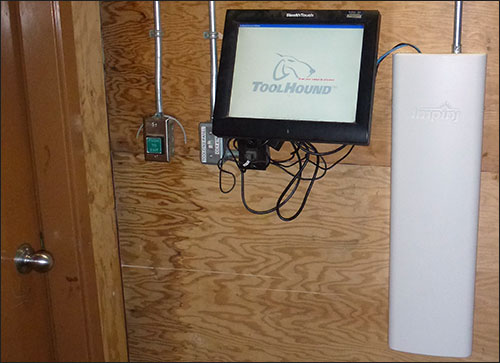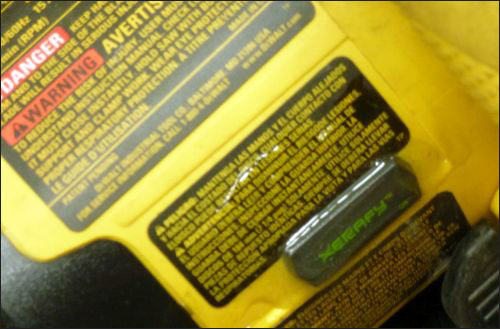A global diamond mining company has deployed an RFID-based solution to manage the tools it loans to its mechanics as they perform maintenance work at its Canadian mine. The Tool and Equipment Tracking system, supplied by ToolHound, an equipment-tracking solution provider based in Edmonton, consists of a tool crib with an ultrahigh-frequency (UHF) RFID reader portal at the entrance, to record who takes and returns which tools, and when this occurs. The software, according to Dean Perry, ToolHound’s president, enables the mining operator, which has asked to remain unnamed, to view which tools have been checked out and when something is overdue for return, as well as who has those assets at any given time.
The mine, which occupies an area measuring nearly two square miles in size, consists primarily of shafts drilled under a lake in the Northwest Territories, though there are also some aboveground operations. The setup includes machinery not only for drilling purposes, but also for collecting and transporting diamond material back to the surface, and the company requires a fleet of mechanics 24 hours a day to provide maintenance for that equipment.
The company faces some unique challenges when it comes to providing its staff with the necessary tools. Individuals conducting mechanical work onsite need very specific equipment so they can provide repairs and maintenance, and being unable to find a tool can thus pose a major problem. The mine can be accessed only when weather permits, either by aircraft or by temporary ice roads. Therefore, the company pays a high price for missing tools—not only due to the cost of the tools themselves, but also the time and rigors of getting them to that remote location.
Each mechanic carries a toolbox filled with basic equipment, but some jobs require specialized tools, such as specific-sized wrenches, drills or saws. Until the RFID system was installed, the company used a manual method to track tools. A mechanic, stationed at the tool crib, oversaw what was being removed or returned, and by whom. He or she wrote that information on a piece of paper, Perry says, though occasionally, workers simply forgot to record that data. This manual process did not give mine management much visibility into what was happening with its tools onsite.
Shrinkage is not a problem at the mine, Perry reports, since no one could steal tools or take them offsite in an airplane. However, staff members have had a tendency to hoard specific tools if they think they will need them again in the future. In this way, they can be sure those items are available to them when needed. But hoarding tools leaves the company with the impression that there are not enough of a specific type of tool, resulting in more being ordered than are actually required onsite.
In July of this year, the mining company installed and began testing ToolHound’s RFID-based solution in its existing tool crib. The 275-square-foot crib has two locked doorways. The outermost door accesses a vestibule that serves as an RFID portal, and a second door leads from the vestibule to the actual crib of tools. Both doors lock from both sides and require that an employee present an RFID-enabled ID badge before they will open. Each mechanic is equipped with an HID low-frequency (LF) RFID badge, which had already been provided for access control in some areas of the mine. The badge tag’s ID number is linked to the mechanic’s identity in ToolHound’s standalone software, residing on a server onsite. (ToolHound also offers a cloud-based solution, but since the mine has no reliable Internet connection, it must run the ToolHound system on a server operating on its premises.) A badge reader is integrated into the locking mechanism at the exterior door. When a mechanic arrives at the crib, he holds his badge next to the reader, which confirms his identity and his authorization to enter, and releases the lock.
The worker enters the portal, passing an Impinj xPortal reader with two built-in antennas. If he is returning any tools, the reader interrogates the ID number of the RFID tag affixed to each item and forwards that information via a cabled connection to the ToolHound software. A touchscreen then displays a list of those tools, linked to the individual carrying them, based on the badge ID he has just presented.
The mechanic reviews the list and selects a prompt indicating that it is accurate, and that he is returning those items. The system then prompts the unlocking of the interior door to the tool crib itself, where he can put the tools away.
At this time, the worker can also select other necessary tools. Before leaving the crib, he must identify himself again via another badge reader located by the doorway. The door lock is then released, and he can proceed to the portal, where the RFID tags of all items are read automatically, and the touchscreen displays a list of all tools. Once the worker verifies that the list of items being borrowed is accurate, the exterior door unlocks.
The solution provides the mine’s managers with a view into which tools are available in the crib, as well as which are not there, due to heavy usage, and thus helps them determine if more of a specific item is needed onsite. Moreover, managers can use the system to ascertain when tools have remained out of the crib for too long. To accomplish this, management can set a time limit for each loan in the software, and if a particular tool is overdue for return, they can view this information on screen.
Most tools have been fitted with passive EPC Gen 2 RFID tags, Perry says—either Xerafy‘s Nano RFID on-metal tag or Metalcraft‘s Standard RFID tag. The tags, which are attached to the tools via adhesive, were selected for their robustness. Tools that are too small for either tag, he notes, are fitted with a bar-coded label. In this case, mechanics must scan the bar-coded ID number in order to indicate that a tool is being borrowed or returned.
ToolHound sometimes provides a handheld Psion Workabout Pro reader for locating equipment within a tool crib or on a job site. The diamond mine is not currently using handhelds, Perry says, but it still stations an employee at the crib during each workday to ensure that the system is operating properly. However, he says, the mine’s managers may opt to eliminate that position in the future, since the system works without a need for human intervention, and the crib attendant can thus be shifted to carrying out mechanical work instead.
The mine has indicated that it hopes the system will end the practice of hoarding, make tools more available to personnel and thereby increase staff efficiency. It also wants to reduce the number of tools it has on hand. The firm has initially acquired 1,000 RFID tags, which it is still attaching to some equipment, with workers inputting each item’s RFID number and description into the ToolHound system.




